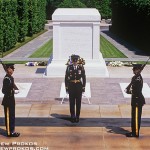 As this is the last year for American combat operations in Afghanistan, this is my post from Memorial Day 2012, when I wrote about Section 60 – where those who lost their lives in Iraq and Afghanistan are interred.
As this is the last year for American combat operations in Afghanistan, this is my post from Memorial Day 2012, when I wrote about Section 60 – where those who lost their lives in Iraq and Afghanistan are interred.
——————————————–
It is impossible to go to Arlington National Cemetery and not be affected by the experience.
I have visited Arlington regularly over the years, and in each trip, I am continually awed by the cemetery’s solemn dignity – its power to dissolve whatever personal presumption and conceit we enter with, leaving us with only a profound and durable humility.
This Memorial Day weekend visit, I chose to pay my respects to the veterans of Afghanistan and Iraq, buried in Section 60 of Arlington National Cemetery.
Driving in Arlington is prohibited, except for family members who are issued special permits. Unless you take one of the arranged Tour-mobiles, your only means to get around is to walk. And walking the cemetery only adds to the awe of the surroundings.
Section 60 is about a half mile down Eisenhower Drive on the left. As you move down the road, the hills that make up the majority of Arlington climb up on the right, while the terrain is flat on the left. The marble headstones on either side are in perfect symmetrical order.
Even with all the Memorial Day activity, the grounds still emit an easing peace and calm, in contrast to the suburbs just beyond, and the city across the river.
Section 60 is not exclusive to those who died in Iraq and Afghanistan. When you read the marble headstones closest to the road, you see that many are veterans who were born in the first two decades of the 20th century. Whether by coincidence or intention, the rest of Section 60 is now home to servicemen who died in the first two decades of the 21st.
When walking among the headstones of our nation’s most recently fallen, it is difficult not to become emotional.
The first thing you notice is their age.
They were so young….
All wars take men in their prime, but for me on this day, the connection was real and jarring.
As I read the dates of birth on each headstone, I could trace the steps in my own life. One solider had been born when I had graduated high school. Another when I had graduated college. Still another as I was in the first job in my career.
And they were already gone.
Having chosen the path of service, and having paid the ultimate price at so early an age, these brave souls would never have the chance to do the things I had taken for granted as I grew older.
Lives unlived. Potential unmet.
It was a deeply humbling experience.
Arlington has very strict rules regarding mementos that can be left at grave-sites. The goal is to create a uniformity that complements the reflective simplicity of the grounds.
But not Section 60.
Family members and friends have left all sorts of tributes, which go untouched by groundskeepers. Many of the headstones are adorned with small, smooth, colored stones. Others have placed rocks at the base of the headstones with messages written from family and friends.
The messages can be heart-breaking.
On this day, Section 60 has many visitors.
There is a family that has brought the dog of the slain soldier. Two rows away, a young woman sits quietly. She wears a t-shirt that memorializes the young soldier whose headstone she stares at.
The grief is palpable.
Amid the sorrow, there is also a sense of foreboding.
After the last row of marble, there is another row of newly-filled graves with only small markers to identify the fallen, awaiting their headstones. From the flower arrangements, it appears that one soldier was laid to rest only the day before.
And beyond that row, there is open land; space reserved for future warriors who will one day pay the ultimate price for our country.
Walking back from Section 60, I dwelled on the often stated refrain, “Where do we find such men (and women)?” To have so many that risk what is most precious in the service of ideals, and fellow citizens they do not even know.
Lost in our day-to-day concerns, it is easy to forget about those who endure long deployments in combat zones, away from family and friends, risking death. It seems that no error in their conduct goes unreported, though the thousands of acts of random kindness – the embodiment of our national character – are rarely recognized.
As a nation, we are so blessed to have – and to have had – men and women willing to risk so much on our behalf.
Retracing my steps on Eisenhower Drive, the sun has come out, and the rays glint off the marble headstones. And though I am alone on the road, the bright marble creates the sense that I am among many. As I walk slowly by, the headstones seem like silent sentinels, each standing a post for posterity, a collective reminder of freedom’s cost.
Theirs was a sacrifice made willingly.
Ours is a debt beyond words that cannot be repaid, only remembered.
